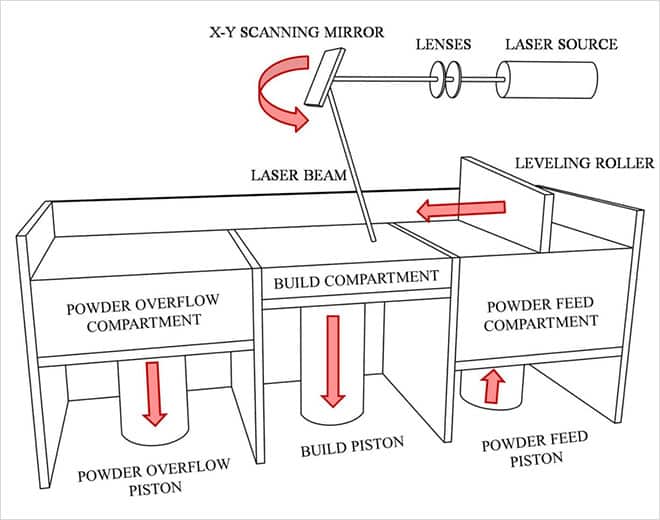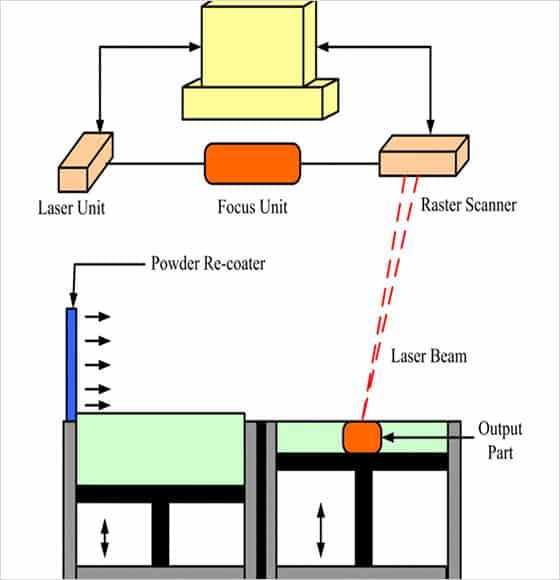Processes
- Polymer Processing
- Injection Molding Insert Molding Blow Molding Over Molding Metal Injection Molding Thermoforming
- Metal Casting
- Die Casting Castings & Forgings Wax Casting Lost Wax Casting Grey Iron Castings Centrifugal Casting Investment Casting Permanent Mold Sand Casting Shell Mold Casting Aluminum Investment Casting Brass Investment Casting Steel Investment Castings Titanium Investment Casting
- Machining
- Milling Turning EDM machining CNC Engraving Hole-making Tap Size Chart Drill Size Chart 5 axis machining Micro Machining CNC Cutting Metal Processes Ceramic Manufacturing Swiss Precision Machining
Materials
Direct metal laser sintering is a 3D printing technique that melts and fuses layers of metallic powder using a computer-controlled, high-power laser beam. DMLS is an industrial 3D printing method that creates fully-functioning fast metal prototypes and production components in as little as 7 days. A variety of metals are employed to create finished pieces that may be employed in end-use applications.
Beginning in 1994, Rapid Product Innovations (RPI) and EOS GmbH collaborated to create Direct Metal Laser Sintering as the first commercial rapid prototyping technology to make metal components in a single process. DMLS uses the metal powder that is devoid of binder or fluxing agent and is melted by scanning a high-power laser beam to create a component with the qualities of the original material. By removing the polymer binder, the burn-off and infiltration processes are avoided, resulting in a 95 percent dense steel product as opposed to around 70 percent density with Selective Laser Sintering (SLS). Another advantage of the DMLS technique over SLS has improved detail resolution owing to the usage of thinner layers made possible by a smaller particle diameter. This feature enables more complex part forms. Alloy steel, stainless steel, tool steel, aluminum, bronze, cobalt-chrome, and titanium are now available as material alternatives. DMLS is often used to create quick tooling, medical implants, and aerospace components for high heat applications, in addition to functioning prototypes.

The Process Of Direct Metal Laser Sintering
The DMLS machine starts the 3D metal printing process by sintering each layer—first the support structures to the base plate, then the object itself—with a laser pointed at a bed of metallic powder. After micro-welding a cross-section layer of powder, the build platform lowers and a re-coat blade travels over the platform to deposit the next layer of powder into an inert build chamber. The method is continued layer by layer until the construction is finished. When the construction is completed, pieces are manually brushed to remove the bulk of loose powder, followed by the appropriate heat-treat cycle while still fixtured in the support systems to alleviate any tensions. Pieces are taken from the platform, and support structures are removed from the parts, before finishing with any bead blasting and deburring that is required. The final DMLS pieces are almost 100% dense.
The Process Methods Of DMLS
The DMLS process may be carried out in two ways: powder deposition and powder bed, which vary in how each layer of powder is deposited. The metal powder is held in a hopper in the powder deposition process, which melts the powder and deposits a thin layer onto the build platform. The powder dispenser piston elevates the powder supply in the powder bed technique (shown below), and a re-coat arm spreads a layer of powder over the powder bed. The powder metal layer is subsequently sintered using a laser. After completing a layer, the build piston lowers the build platform and the next layer of powder is placed. The powder deposition technique has the benefit of allowing the use of many materials, each in its hopper. The powder bed approach is confined to a single material but allows for speedier construction times.

| Capabilities | |
|---|---|
| Abbreviation | DMLS |
| Tolerance | 0.01in. |
| Min Feature Size | 0.005 in. |
| Min Layer Thickness | 0.001 in. |
| Max Part Size | 10.00 x 10.00 x 8.70 in. |
| Surface finish | Average |
| Material type | Metal-Based Powder |
| Build speed | Fast |
| Materials | Ferrous metals such as Steel alloys,Tool steel; Stainless steel, Non-ferrous metals such as Aluminum, Bronze |
| Applications | Rapid Prototyping & Mass Pro |